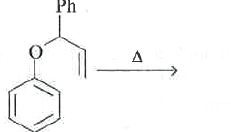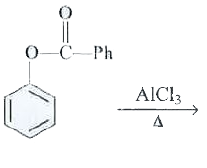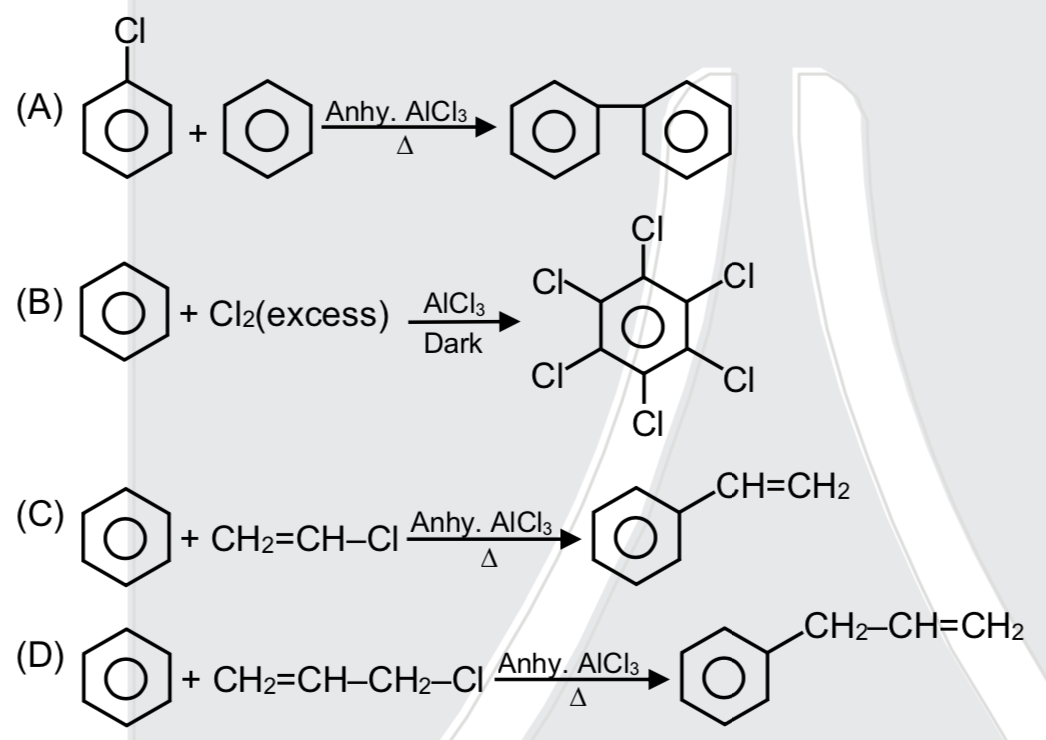In which of the following reactions, rearrangement is possible ?
E1
SN1
SN2'
E1cB
The correct Answer is:A, B, C
To determine in which of the following reactions rearrangement is possible, we will analyze each reaction type: E1, SN1, SN2, and E1CB.
1. Understanding E1 Reactions:
- E1 stands for unimolecular elimination. This reaction proceeds through a two-step mechanism where a carbocation intermediate is formed after the leaving group departs.
- Since rearrangement can occur at the carbocation stage (to form a more stable carbocation), rearrangement is possible in E1 reactions.
2. Understanding SN1 Reactions:
- SN1 stands for unimolecular nucleophilic substitution. Similar to E1, this reaction also involves a two-step mechanism where a carbocation intermediate is formed.
- Rearrangement can occur at the carbocation stage to form a more stable carbocation, making rearrangement possible in SN1 reactions.
3. Understanding SN2 Reactions:
- SN2 stands for bimolecular nucleophilic substitution. This reaction occurs in a single step, where the nucleophile attacks the substrate as the leaving group departs.
- Since there is no carbocation intermediate formed in SN2 reactions, rearrangement does not occur in this type of reaction.
4. Understanding E1CB Reactions:
- E1CB stands for unimolecular elimination via a conjugate base. This reaction occurs under basic conditions and involves the formation of a carbanion intermediate.
- The carbanion formed is typically stable and does not undergo rearrangement because it is an irreversible step. Thus, rearrangement is not possible in E1CB reactions.
Conclusion:
From the analysis above, rearrangement is possible in E1 and SN1 reactions due to the presence of carbocation intermediates. Rearrangement is not possible in SN2 and E1CB reactions.
Correct Options: E1 and SN1 (Options A and B)
- E1 stands for unimolecular elimination. This reaction proceeds through a two-step mechanism where a carbocation intermediate is formed after the leaving group departs.
- Since rearrangement can occur at the carbocation stage (to form a more stable carbocation), rearrangement is possible in E1 reactions.
- SN1 stands for unimolecular nucleophilic substitution. Similar to E1, this reaction also involves a two-step mechanism where a carbocation intermediate is formed.
- Rearrangement can occur at the carbocation stage to form a more stable carbocation, making rearrangement possible in SN1 reactions.
- SN2 stands for bimolecular nucleophilic substitution. This reaction occurs in a single step, where the nucleophile attacks the substrate as the leaving group departs.
- Since there is no carbocation intermediate formed in SN2 reactions, rearrangement does not occur in this type of reaction.
- E1CB stands for unimolecular elimination via a conjugate base. This reaction occurs under basic conditions and involves the formation of a carbanion intermediate.
- The carbanion formed is typically stable and does not undergo rearrangement because it is an irreversible step. Thus, rearrangement is not possible in E1CB reactions.
From the analysis above, rearrangement is possible in E1 and SN1 reactions due to the presence of carbocation intermediates. Rearrangement is not possible in SN2 and E1CB reactions.
Topper's Solved these Questions
- BOOK - CENGAGE CHEMISTRY ENGLISHCHAPTER - ORGANIC REACTION MECHANISMEXERCISE - Single correct43videos
ORGANIC REACTION MECHANISM
- BOOK - CENGAGE CHEMISTRY ENGLISHCHAPTER - ORGANIC REACTION MECHANISMEXERCISE - Assertion-Reasoning12videos
ORGANIC REACTION MECHANISM
- BOOK - CENGAGE CHEMISTRY ENGLISHCHAPTER - ORGANIC REACTION MECHANISMEXERCISE - Comprehension35videos
ORGANIC REACTION MECHANISM
- BOOK - CENGAGE CHEMISTRY ENGLISHCHAPTER - NCERT BASED EXERCISEEXERCISE - Chemical Equilibrium73videos
NCERT BASED EXERCISE
- BOOK - CENGAGE CHEMISTRY ENGLISHCHAPTER - P-BLOCK GROUP 13 - BORON FAMILYEXERCISE - Exercise Archives (Subjecive)9videos
P-BLOCK GROUP 13 - BORON FAMILY
Similar Questions
Knowledge Check
- Question 1 - Select One
Under common reaction conditions, a carbocation rearranges to another carbocation of equal or greater stability. For example, a secondary carbocation will rearrange to a tertiary carbocation. It will not rearrange to a less stable primary carbocation. This generalization is not absolute, and because there is not a high energy barrier to the rearrangement of carbocations, rearrangement to a less stable cation can occur if it offers the chance to form a more stable product.
In which of the following cations rearrangement takes place?A B
B C
C D
D
- Question 2 - Select One or More
Which of the following reactions involve rearrangement?
A B
B C
C D
D
- Question 3 - Select One
In which offollowing reaction rearrangement take place with change in carbon skeleton
ACH3−CH3∣C∣CH3−⊕CH2BCH3−CH2CH⊕2CCH3−C∣CH3H−CH2−⊕CH2DCH3−CH⊕−CH3
Which of the following reactions are possible ?
 View Solution
View SolutionIn which of the following species resonance is possible?
View SolutionWhich of the following is not a rearrangement reaction ?
View SolutionWhich of the following is true ?
View SolutionWhich of the following reaction is possible ?
View Solution
